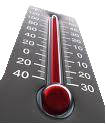HOW HOT IS YOUR WASH WATER
The other day I was visiting a friend at his Laundromat and a well-dressed lady in a suit approached me and handed me her card. She was from the Los Angeles Department of Health and was there to do a health inspection of the Laundromat. My heart sank. I didn't even own the Laundromat and my stomach was doing a flip-flop. My years in the business have taught me that very little good can be on the way when a government suit inspects. Clipboard in hand she went over all the store areas, looking for bugs, broken machines, mold and finally pulling out a thermometer to measure the water temperature. I thought to myself "here we go again with the 140 degree hot water request." The water was 138 degrees and the inspector said she would not cite the location. I thought great, because I knew one half of the natural gas bills goes to heating hot water and If you raise the temperature too high you run the risk of scalding your customers and increasing your gas bill. I have always believed, along with most owners, there is no germicidal benefit of water temperatures below 180 degrees. Most Laundromats keep their hot water at between 120 and 130 degrees so save money on their utility bills. Then I read this article.
"CLEAN" LAUNDRY STILL DIRTY"
by AOL Health Editors May 14, 2010
Your underwear is dirty -- even the undergarments that just came out of the dryer smelling as sweet as a spring
morning. Why? Twenty-five percent of home washing machines are contaminated with fecal bacteria, according
to Dr. Charles Gerba of the University of Arizona in Tucson. How does this happen? While it has never been proven that bacteria on clothing spread illness, Gerba told The Housekeeping Channel that each pair of dirty underwear contains about one-tenth of a gram of bacteria-carrying feces, which is about the same size as a quarter of a peanut. Detergent and water remove 99 percent of those nasty organisms -- but not all of them.
Why is our laundry still so dirty?
1. Wash cycles and drying cycles are shorter now, averaging 20 and 28 minutes
respectively.
2. Most of us do not use hot water to wash our clothes and even fewer use bleach.
3. The mechanical action and proper rinsing away of soil and microbes is not as
effective when a washing machine is overloaded, since overloading can inhibit the
flow of water through fabrics for dispersal of the detergent.
4. Microbes from one wash load can stay in the washer and be transferred to the
next load.
5. Leaving wet laundry in a washing machine for hours creates a prime breeding ground
for bacteria.
6. Some microbes even survive the dryer's heat, including salmonella, hepatitis A,
rotavirus and adenovirus, however they do survie an ozone injection.
What you can do to get cleaner laundry? Gerba advises the following:
1. Wash your white underwear with one cup of bleach added to the wash water.
2. If you don't want to use bleach on your clothing, run one wash cycle with only
bleach and water to disinfect the machine either before your first load or after
the last.
3. Wash clothes at a temperature of 140 degrees or higher. (Although frankly, this is
difficult for most household washing machines.)
4. Use a detergent that contains a sanitizer, especially if you like to wash clothes
in cold water.
5.
When transferring wet clothes from the washer to the dryer, wear protective gloves
or wash your hands immediately afterward.
FINAL COMMENT
I have increased my water temperature and leave all the lids on the top load washers and the doors on the front load washers wide open every night to air out the interiors to decrease the chance of mold growth. I also will run a load of bleach through each washer once a month, just in case someone washed their dirty undies in my machines.




DO YOU NEED 140 DEGREE WATER?


